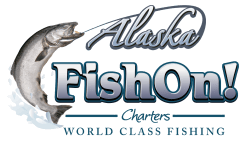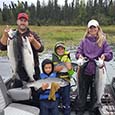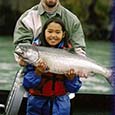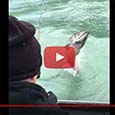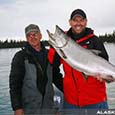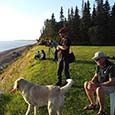Alaska Salmon Fishing with Alaska Fish On Charters!
Why book your Alaska salmon fishing trip with Alaska Fish On? Because Alaska Fish On Charters specializes in guided fishing trips on the famous Kenai River and offers other wildlife services, too, like bear viewing trips in the great Alaskan wilderness. If it’s Alaska salmon fishing you want, Gary is the man to see. With more than 37 years of experience guiding Alaska salmon fishing, he’s a favorite of both clients and fellow salmon fishing guides. According to the State of Alaska Department of Natural Resources, Gary respects the area’s environment and “provides a safe and positive experience for his clients.”
A sportfishing expert in the four species that are common in the Kenai Peninsula (King, Sockeye, Coho, and Pink), Gary has the experience to know which fish are worth keeping and which are starting to turn bad. Alaska salmon fishing guides should be familiar with the entire river system, Alaska Fish On Charters! knows where to go when the fishing in one area is not as good as it could be.
It’s more than a business with Gary; it’s a passion. That means he’ll go out of his way to make sure your Alaska salmon fishing expedition is as productive as possible. Gary believes that making clients happy will create more clients down the road–and give him more chances to share his love of Alaska salmon fishing.
See our Alaska Fishing Packages today for some outstanding deals on the upcoming Alaska salmon fishing season. Let us take the hassles out of planning your vacation. Call us today and ask about our early bird specials.
Be the first to book. New itineraries, unheard of deals on the Best Of Alaska and it’s all On Sale today! Check out our Alaska Fishing Packages
Alaska Salmon FAQs
How many species of Pacific salmon are there?
Pacific salmon is a generic term used to describe those members of the genus Oncorhynchus that die after spawning. At present, there are seven species commonly referred to as Pacific salmon. There are five species that occur on both sides of the Pacific Ocean:
- Chinook Salmon (Oncorhynchus tshawytscha) a.k.a. king salmon
- Chum Salmon (Oncorhynchus keta) a.k.a. dog salmon
- Coho Salmon (Oncorhynchus kisutch) a.k.a. silver salmon
- Pink Salmon (Oncorhynchus gorbuscha) a.k.a. humpback salmon
- Sockeye Salmon (Oncorhynchus nerka) a.k.a. red salmon
Two species occur only in Asia:
- Masu Salmon (Oncorhynchus masou) a.k.a. yamame
- Amago Salmon (Oncorhynchus rhodurus) a.k.a. biwamasu
An excellent discussion of the varied life histories of these seven species can be found in C. Groot and L. Margolis [editors] 1991. Pacific Salmon Life Histories, University of British Columbia Press, 564 pp.

Coho Salmon

Pink Salmon
Is it true that salmon return to spawn in freshwater areas where they were born?
Almost always. Some straying has been documented, but it is minor. Most spawning salmon return to the precise stream of their birth, sometimes overcoming great distances and hazardous river conditions to reach home.
What is the difference between the Atlantic salmon and the Pacific salmon?
The Atlantic Salmon (Salmo salar) is actually one species within the genus Salmo. Pacific salmon are represented by seven different species, see question above, and belong to the genus Oncorhynchus. The seven Pacific salmonspecies have life histories that are extremely complex and vary widely within and between species. However, all the Pacific salmon die shortly after spawning. Atlantic salmon have a much less variable range of life history strategies across the species and have high post spawning mortality but are capable of surviving and spawning again.

Atlantic Salmon
Weights of 100 pounds and slightly over have been reported from European countries for the Atlantic salmon; the record for the largest of the Pacific species, chinook, is 126 pounds for a fish caught on commercial gear in Alaskan waters.
Are steelhead (rainbow trout) trout or salmon?
Until 1988, steelhead (the anadromous form of rainbow trout) was classified in the genus Salmo along with Atlantic salmon, brown trout, and several western trout species. With additional osteology and biochemistry data, biologists have now reclassified steelhead as members of the genus Oncorhynchus. The reason for this is that new information suggested that steelhead are more closely related to Pacific salmon than to brown trout and Atlantic salmon. As such, the American Fisheries Society – American Society of Ichthyologists Committee on Names of Fishes voted unanimously to accept Oncorhynchus as the proper generic name. For full scientific details, see Smith, G. R., and R. F. Stearley. 1989. The classification and scientific names of rainbow and cutthroat trouts. Fisheries 14 (1): 4-10. As such, the scientific name of steelhead was changed from Salmo gairdneri to Oncorhynchus mykiss. The generic names of the golden, Mexican golden, Gila, and Apache trouts were also changed to Oncorhynchus. Since all of these western trouts including steelhead are biologically capable of repeat spawning and do not die after spawning, it has been suggested this group be called the Pacific trout.
Where do salmon go in the ocean?
 Contrary to earlier beliefs, many salmon from North American rivers roam far at sea in the North Pacific Ocean and the Bering Sea. The oceanic distribution of the salmon is dependent upon the species and point of origin. Sockeye and chinook salmon from northwest Alaska, for example, may migrate across the Bering Sea to areas close to Kamchatka, U.S.S.R., and south of the Aleutian Islands into the North Pacific Ocean; the sockeye also migrate eastward to the Gulf of Alaska. Salmon such as the pink, chum, and coho from central and southeast Alaska, British Columbia, and Washington State, migrate out into the northeastern Pacific and Gulf of Alaska. Many steelhead trout from Washington and Oregon are known to migrate far at sea to areas off the Alaskan Peninsula. Some salmon migrate several thousand miles from the time they leave the rivers as juveniles until they return as adults. A chinook salmon tagged in the central Aleutian Islands and recovered a year later in the Salmon River, Idaho, had traveled about 3,500 miles; a steelhead trout tagged south of Kiska Island (western Aleutians) was recovered about six months and 2,200 miles later in the Wynoochee River, Washington.
Contrary to earlier beliefs, many salmon from North American rivers roam far at sea in the North Pacific Ocean and the Bering Sea. The oceanic distribution of the salmon is dependent upon the species and point of origin. Sockeye and chinook salmon from northwest Alaska, for example, may migrate across the Bering Sea to areas close to Kamchatka, U.S.S.R., and south of the Aleutian Islands into the North Pacific Ocean; the sockeye also migrate eastward to the Gulf of Alaska. Salmon such as the pink, chum, and coho from central and southeast Alaska, British Columbia, and Washington State, migrate out into the northeastern Pacific and Gulf of Alaska. Many steelhead trout from Washington and Oregon are known to migrate far at sea to areas off the Alaskan Peninsula. Some salmon migrate several thousand miles from the time they leave the rivers as juveniles until they return as adults. A chinook salmon tagged in the central Aleutian Islands and recovered a year later in the Salmon River, Idaho, had traveled about 3,500 miles; a steelhead trout tagged south of Kiska Island (western Aleutians) was recovered about six months and 2,200 miles later in the Wynoochee River, Washington.
What is a kokanee, or silver trout?
It is the landlocked subspecies of a sockeye salmon. The kokanee spends its entire life in fresh water and usually does not attain the size of its sea-migrating cousin.
